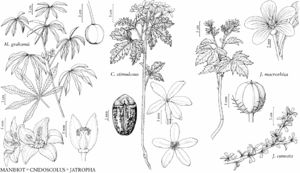Difference between revisions of "Manihot grahamii"
Icon. Pl. 6: plate 530. 1843. (as grahami)
FNA>Volume Importer |
imported>Volume Importer |
||
| (5 intermediate revisions by 2 users not shown) | |||
| Line 6: | Line 6: | ||
|place=6: plate 530. 1843 | |place=6: plate 530. 1843 | ||
|year=1843 | |year=1843 | ||
| + | |other_info_on_pub=(as grahami) | ||
}} | }} | ||
|common_names=Hardy tapioca;Graham's manihot or cassava | |common_names=Hardy tapioca;Graham's manihot or cassava | ||
| Line 13: | Line 14: | ||
}}{{Treatment/ID/Special_status | }}{{Treatment/ID/Special_status | ||
|code=F | |code=F | ||
| − | |label= | + | |label=Illustrated |
}} | }} | ||
|basionyms= | |basionyms= | ||
| Line 31: | Line 32: | ||
|elevation=0–600 m. | |elevation=0–600 m. | ||
|distribution=Ala.;Ark.;Fla.;Ga.;La.;Miss.;Tex.;South America. | |distribution=Ala.;Ark.;Fla.;Ga.;La.;Miss.;Tex.;South America. | ||
| + | |introduced=true | ||
|discussion=<p><i>Manihot grahamii</i> is native to northern Argentina, southeastern Brazil, Paraguay, and Uruguay, and is sometimes cultivated for its distinctive, attractive foliage. The flowers are relatively inconspicuous, but are much-visited by bees. This is the most cold-tolerant <i>Manihot</i> species; above-ground stems survive light frosts and if severe cold kills the aerial shoot system outright, new stems can regenerate from underground parts. It survives well and self-sows in garden settings as far north as tidewater Virginia; northern limits for the persistence of plants escaping from cultivation have yet to be established. In addition to characteristics noted in the key, herbarium specimens frequently exhibit contracted petiole bases.</p> | |discussion=<p><i>Manihot grahamii</i> is native to northern Argentina, southeastern Brazil, Paraguay, and Uruguay, and is sometimes cultivated for its distinctive, attractive foliage. The flowers are relatively inconspicuous, but are much-visited by bees. This is the most cold-tolerant <i>Manihot</i> species; above-ground stems survive light frosts and if severe cold kills the aerial shoot system outright, new stems can regenerate from underground parts. It survives well and self-sows in garden settings as far north as tidewater Virginia; northern limits for the persistence of plants escaping from cultivation have yet to be established. In addition to characteristics noted in the key, herbarium specimens frequently exhibit contracted petiole bases.</p> | ||
|tables= | |tables= | ||
| Line 40: | Line 42: | ||
-->{{#Taxon: | -->{{#Taxon: | ||
name=Manihot grahamii | name=Manihot grahamii | ||
| − | |||
|authority=Hooker | |authority=Hooker | ||
|rank=species | |rank=species | ||
| Line 55: | Line 56: | ||
|publication title=Icon. Pl. | |publication title=Icon. Pl. | ||
|publication year=1843 | |publication year=1843 | ||
| − | |special status=Introduced; | + | |special status=Introduced;Illustrated |
| − | |source xml=https:// | + | |source xml=https://bitbucket.org/aafc-mbb/fna-data-curation/src/2e0870ddd59836b60bcf96646a41e87ea5a5943a/coarse_grained_fna_xml/V12/V12_985.xml |
|genus=Manihot | |genus=Manihot | ||
|species=Manihot grahamii | |species=Manihot grahamii | ||
Latest revision as of 19:18, 5 November 2020
Shrubs or trees, 2–6[–7] m. Roots not thickened. Stems erect, angled when young; nodes not swollen; leaf and stipule scars not elevated. Leaves deciduous; stipules linear, remotely serrate; petiole 5–33 cm; blade basally attached, 5–13-lobed, median and adjacent lobes with pair of weakly defined rounded secondary lobes distal to middle, lateral lobes without secondary lobes, median lobe 5–24 cm, margins neither thickened nor revolute, entire, apex acuminate, surface glabrous, abaxial smooth. Inflorescences axillary, panicles, to 30 cm. Pedicels: staminate 4–10 mm; pistillate 10–40 mm in fruit, straight. Staminate flowers: calyx campanulate, 10–15 mm, lobes erect or spreading; stamens 10. Capsules 1.8 cm, smooth, not winged. Seeds oblong, 10–12 mm.
Phenology: Flowering Apr–Aug; fruiting Jun–Sep.
Habitat: Disturbed areas, spreading from cultivation.
Elevation: 0–600 m.
Distribution
Introduced; Ala., Ark., Fla., Ga., La., Miss., Tex., South America.
Discussion
Manihot grahamii is native to northern Argentina, southeastern Brazil, Paraguay, and Uruguay, and is sometimes cultivated for its distinctive, attractive foliage. The flowers are relatively inconspicuous, but are much-visited by bees. This is the most cold-tolerant Manihot species; above-ground stems survive light frosts and if severe cold kills the aerial shoot system outright, new stems can regenerate from underground parts. It survives well and self-sows in garden settings as far north as tidewater Virginia; northern limits for the persistence of plants escaping from cultivation have yet to be established. In addition to characteristics noted in the key, herbarium specimens frequently exhibit contracted petiole bases.
Selected References
None.
